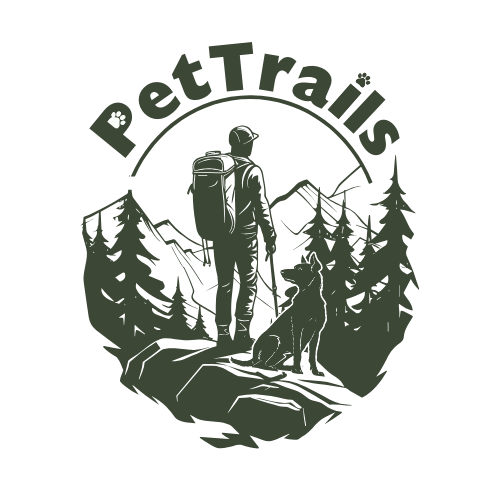
Your Dog's Hiking Experience: A Journey Through All Five Senses
Share
Ever wonder what your dog is actually experiencing on a hike? While we look at views and snap trail selfies, our pups are engaging with the environment on a totally different level. One rooted not just in sight, but in scent, sound, touch, and even taste.
Dogs don’t just walk the trail, they live it, using every sense to read the landscape, detect hidden clues, and savor the journey in ways we can barely comprehend. This post takes you inside that experience, one sense at a time.
Seeing the Trail: A Dog’s Eyes on the World
Contrary to the myth, dogs aren’t colorblind, they see the world primarily in shades of blue and yellow. Reds and greens? They blur into muted browns and grays. But what they lack in color, they make up for in motion sensitivity and low-light vision.
- Motion Matters: Dogs detect movement far better than we do. A squirrel darting through underbrush or a leaf drifting across the trail grabs their attention instantly.
- Twilight Vision: Their eyes are designed for dusk and dawn, which were key hunting hours for their ancestors. That’s why early morning hikes may feel extra special to your pup.
Tip: Avoid brightly colored gear thinking your dog will see it clearly. Go for what contrasts with nature’s palette, like reflective strips or light blues and yellows.
Sniffing the Story: The Nose Leads the Way
We won’t linger here too long (we’ve got a full post dedicated to just sniffing here), but no sensory journey would be complete without mentioning your dog’s super-sniffer.
Every breeze, footprint, or animal trail is a story waiting to be read. It’s how they map the world, track recent visitors, and even sense emotional states in other animals through chemical cues.
Tip: Allow plenty of sniff breaks, especially in open meadows, trailheads, and animal-dense zones. It’s mental enrichment, not a delay.
Hearing the Hidden Sounds of the Wild
Dogs hear much farther than we do and can detect sounds at higher frequencies that are barely audible, or completely inaudible, to humans.
- Distant sounds, such as footsteps approaching from around a bend
- Subtle trail cues, like a squirrel climbing a tree or deer rustling in the brush
- High-frequency tones, like metal clinks, bird chirps, or faint whines
- Ultrasonic sounds, like high-pitched rodent squeaks or electronic noises completely outside our hearing range.
Their hearing plays a critical role in trail awareness and alertness, often causing them to stop or orient long before we know why.
Tip: Be mindful of your dog’s alert posture or sudden ear twitch. They’re picking up things you aren’t. And for noise-sensitive pups, bring calming gear like anxiety wraps or ear covers on crowded trails.
Feeling the Terrain: Paws as Trail Sensors
Your dog’s paws aren’t just for walking, they’re sensory tools. With hundreds of nerve endings, paws help dogs judge:
- Temperature changes, like hot rocks or icy snow
- Texture shifts, such as gravel vs. mud or moss vs. pine needles
- Safety of footing, which explains why some dogs hesitate at bridges, logs, or slick rock
Paw sensitivity can vary by breed and individual. Dogs with thicker paw pads, like huskies or shepherds, may be less reactive to rough terrain than those with finer feet. But even the toughest paws can get sore over time.
Tip: Before hitting rocky or hot trails, let your dog practice on similar terrain at home. And always pack a paw balm or booties for unexpected surfaces.
Tasting the Trail: Caution Required
Yes, dogs use taste to explore too, sometimes to our frustration. Whether it’s licking dew off leaves, nibbling grass, or sampling mysterious trail "snacks," it’s all part of their sensory investigation.
While this behavior is instinctual, not everything they try is safe. Toxic plants, spoiled food scraps, or mushrooms can pose serious risks.
Tip: Use cues like “leave it” or “drop it” early and often, and redirect curiosity with safe trail treats or chew-friendly toys.
A Walk in Their Paws: A Trail Moment, Two Ways
You see: A dusty bend in the trail with a scenic overlook ahead.
Your dog senses:
- A rabbit passed here not long ago
- The breeze carries scent from a creek a mile away
- A bird just landed in a tree behind you
- The ground ahead is cooler, maybe shaded
- Another dog marked a bush just out of view
Every moment is a full-body experience, and your dog is soaking it in like a sponge.
Making the Most of Their Senses
Want to turn every hike into a sensory-rich adventure for your dog? Here’s how:
- Mix up trail types: Forest, grassland, beach, or alpine, each offers new smells and textures.
- Let them lead occasionally: Controlled freedom boosts confidence and independence.
- Use enrichment cues: “Find it” games, scent trails, and foraging treats can keep their minds engaged.
- Watch their signals: Slow down when they’re tuned in, rushing robs them of experience.
Final Thoughts: Tune Into Their World
We often hike for the views, the exercise, or the peace of mind. But for your dog, it’s a journey of discovery with every step. By slowing down and paying attention to how they’re seeing, hearing, smelling, feeling, and even tasting the trail, we build a deeper connection, not just with nature, but with our dogs themselves.
So next time you hit the trail, take a moment to walk in their paws. You might be surprised at what you missed.
